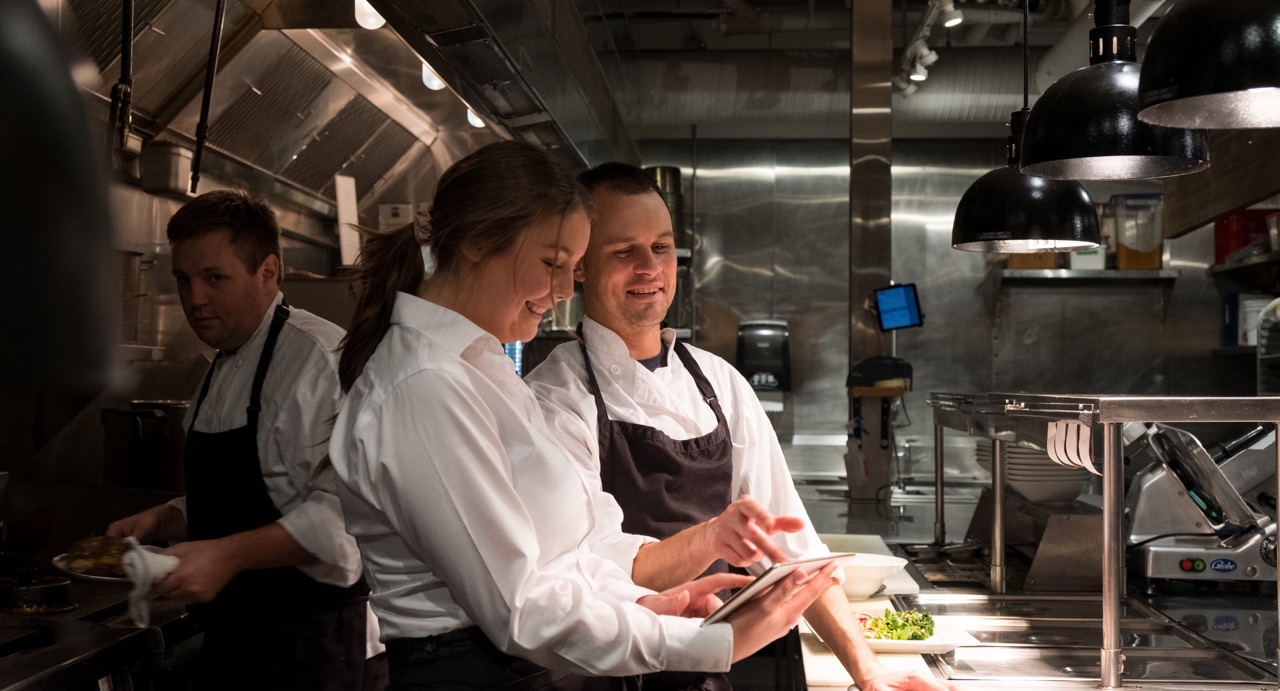Table of Contents

Looking to open a new restaurant, or revitalize your current one with renovations or a new location? You’re likely in need of some capital to get your dream off the ground.
If you feel lost in a sea of restaurant financing options (or even still wondering how much does a restaurant owner make?), look no further. This guide breaks down everything you need to know. Read on for the low-down on the most essential funding and financial strategies for restaurants, as well as their pros and cons.
Restaurant financing options
Whether you’re starting from scratch on a new restaurant idea, renovating, rebranding, or opening a new location, access to capital is crucial to help your restaurant grow.
When it comes to getting your restaurant business off the ground (or revitalizing it), there are three popular options for restaurant financing.
#1 Traditional loans
Perhaps the first method that comes to mind when you think of restaurant financing is a traditional loan. A term loan from a traditional “brick-and-mortar” bank or credit union often requires you to put up collateral (i.e. personal collateral, your restaurant’s real estate, or business equipment) and pay compounded interest. The application process can be tedious, but payback periods are often flexible, simply requiring a monthly bill payment.
You may also consider an SBA (Small Business Administration) Loan. The SBA is a federal government program that acts as a guarantor for your loan with a traditional bank or credit union. This means that your loan will be government-backed, and you’ll likely receive a favorable interest rate (though often not as competitive as that of a traditional term loan).
Another option is a commercial real estate (CRE) loan. Operating the same way as a residential mortgage, a CRE loan works well if you are investing in your restaurant’s first physical location (or subsequent new locations).
#2 Investors
Another financing option to consider is finding an investor. This could mean asking for loans from friends and family (the old-fashioned way) or seeking an angel investor or venture capitalist. Consider reaching out to your extended network—your peers in the industry might be willing to invest, or could refer you to their past investors.
Angel investors are wealthy individuals (anyone from a relative to an experienced professional) who provide an investment (typically smaller amounts under $1 million) in your business in exchange for a stake (typically between 20% and 40%). Angel investors choose to invest based on belief in your business plan and typically want to stay involved in your restaurant business.
Venture capitalist firms seek to invest in growing businesses. By pulling funding from other investors, corporations, pension funds, insurance companies, and more, they are able to provide a much larger sum (typically over $1 million) in exchange for a (typically 20% to 30%) stake in your (larger) business. Venture capitalist firms typically aim to maximize profits in a short period of time and likely will not stay involved with your restaurant long-term.
#3 Alternative methods
The list of ways to finance your restaurant doesn’t stop with traditional loans and investors. There are other paths to securing funding that might not be on your radar.
Here are a few options:
- A crowdfunding campaign – Using platforms like Kickstarter or Indiegogo, set a monetary goal and source the funds from your community. This will also serve to spread the word about your restaurant and garner interest in its grand opening.
- Merchant cash advance – A merchant cash advance or business cash advance involves a lender paying you a lump sum upfront in exchange for a percentage of your future sales at a discount. This means that you’ll agree to a fixed “monthly repayment percentage” rather than paying compounding interest—a worthy option if you’re not sure how long it will take you to pay back the loan.
- Business line of credit – A business line of credit works the same way as a credit card: you borrow as much as you need up to a certain amount, and pay back your debt with interest each month. This option works well if you’ll need varying amounts of funding each month, as you’ll only need to pay interest on what you borrow.
- Equipment financing – If you are looking to invest in renovations or new equipment for your kitchen, equipment financing is an option worth considering. This process involves purchasing equipment (or securing the funds to do so) from an equipment financing company, and then paying the company back in monthly increments with interest.
- Purchase order financing – This method allows restaurants that have already taken orders for a product to borrow the capital needed to fulfill those orders from a purchase order financing company. The company pays your supplier directly, and you pay them back with interest. This works particularly well if your restaurant sells one of its signature ingredients (i.e. a special sauce), and can even allow you to explore selling that product elsewhere (i.e. in grocery stores).

Loan applications: before you get started
If you decide that a traditional loan is the best way to fund your food haven, there are some records to have in order before you dive in.
Start by compiling credit scores for yourself and any business partners. Then, develop a financial plan. This is a set of documents outlining your restaurant’s current monetary situation, your financial goals, and the steps you plan to take to achieve them.
Determine whether your restaurant will be an LLP (limited liability partnership, protects business partners should the other partner fail to fulfill their duties) or an LLC (limited liability company, protects the sole owner from their business’s debts and liabilities).
This will affect how you pay taxes and debts. While there’s no set format in terms of the documents you’ll need, it’s also a good idea to gather information such as total startup costs, sales projections, and an overhead budget.
FInally, make copies of your business plan. Unlike a financial plan (which is more of a financial forecast), a business plan details how you plan to achieve your business goals. This might include a description of your restaurant and its target demographic, your marketing campaign plans and funding requirements, and other strategies you plan to implement.
These elements are important ones your loan provider will want to know in order to determine how trustworthy you’ll be to pay back your loan.
Restaurant financing challenges
Financing your restaurant can be quite the undertaking. It’s crucial to be prepared to face common challenges as you navigate the world of securing funding.
Navigating loan terms
Navigating loan terms is all about paying attention to the fine print.
Make sure you’re aware of the guidelines you’re agreeing to follow. Take note of the principal loan amount, the interest rate, the repayment terms (the schedule on which the loan must be paid back), and any fees and penalties.
Note that you might be charged for late payment, or even early completion of the repayment period.
Interest rates
Take note of your interest rate upon receiving your loan, and estimate how much you’ll pay in compounded interest should you complete your repayment plan on time.
Interest rates for private loans vary and depend on factors like your credit score, but commonly fall between 10% and 20%. Maintaining your credit score will save you thousands of dollars in the long run—a difference of just over a hundred points could add a whole percent point to your interest rate.
Repayment plans
Pay attention to the details of your repayment plan. Note how long you’ll have to pay back your loan, any fees or penalties, and key checkpoints along the way.
Short-term business loans typically come with repayment plans lasting anywhere from a few months to several years (and are typically used for immediate needs like paying bills or restocking inventory).
Long-term business loans typically come with repayment plans of up to 25 years (and are typically used for bigger investments, like real estate or a kitchen’s worth of equipment).
Other common challenges
If you’ve been in the restaurant business for a while, you know that the financial end of the business can fluctuate like the weather. So while you financially plan for your restaurant, organize a plan A and a plan B—just in case.
Second, if you plan to borrow money, ensure you’re borrowing the right amount—a number that will support your restaurant and increase your income without causing undue financial stress.
Finally, while the food may be the center of your business, your staff puts it on customers’ plates. Making smart staffing decisions is part and parcel of a smart financial plan.
While 63% of American adults have worked in the restaurant industry, 90% of restaurants have fewer than 50 employees. Do your best to ensure that your staff is small but mighty, with as many experienced and passionate employees as possible (even if a few are novices looking to gain experience).
Simplify restaurant financing with CloudKitchens
If dealing with loans, angel investors, and merchant cash advances makes your head spin, there is another alternative: CloudKitchens. We provide commercial kitchen space and a delivery platform to expand your reach and grow your business with minimal start-up capital.
Start by renting a CloudKitchens ghost kitchen fitted with basic equipment, and then use it to achieve your vision. CloudKitchens provides the technology needed to track delivery orders from any popular delivery app through a single tablet. All you’ll need to do is staff up with a few back-of-house team members and get cooking.
Once each order is complete, CloudKitchens takes care of the rest, ensuring it’s smoothly delivered to the right customer through their chosen delivery service. If you’re looking to expand your restaurant and reach new clientele without the hassle of traditional restaurant financing, CloudKitchens has you covered.
Explore ghost kitchen locations across the US:
- Ghost kitchens in Seattle
- Ghost kitchens in San Francisco
- Ghost kitchens in LA
- Ghost kitchens in NYC
- Ghost Kitchens in Toronto
- Ghost Kitchens in Atlanta
- Ghost Kitchens in Dallas
- Ghost Kitchens in Chicago
- Ghost Kitchens in Denver
- Ghost Kitchens in Miami
| DISCLAIMER: This information is provided for general informational purposes only and the content does not constitute an endorsement. CloudKitchens does not warrant the accuracy or completeness of any information, text, images/graphics, links, or other content contained within the blog content. We recommend that you consult with financial, legal, and business professionals for advice specific to your situation. |
Sources:
Duquesne University. What You Need to Know About Small Business Administration (SBA) Loans. //www.sbdc.duq.edu/Blog-Item-What-you-need-to-know-about-Small-Business-Administration-SBA-Loans
Score.org. Understanding Differences Between Angel Investors and Venture Capitalists. https://www.score.org/resource/blog-post/understanding-differences-between-angel-investors-and-venture-capitalists?gad_source=1&gclid=Cj0KCQiAw6yuBhDrARIsACf94RWWCsSw5MLZ6oNUYFza1FWhr47-Z9Qx6ivyDjk4JfBOrUaUUYlZWTUaAspUEALw_wcB
Forbes. Purchase Order Financing. https://www.forbes.com/advisor/business-loans/purchase-order-financing/
FINRA. How Your Credit Score Impacts Your Financial Future. https://www.finra.org/investors/personal-finance/how-your-credit-score-impacts-your-financial-future#:~:text=The%20riskier%20you%20appear%20to,from%20approximately%20300%20to%20850.
LinkedIn. What Repayment Terms. https://www.linkedin.com/pulse/what-repayment-terms-business-loans-saiful-islam-1c#:~:text=Repayment%20periods%20can%20range%20from,paying%20bills%20or%20purchasing%20inventory.
National Restaurant Association. Industry Statistics. https://restaurant.org/research-and-media/research/industry-statistics/national-statistics/
More insights & stories

